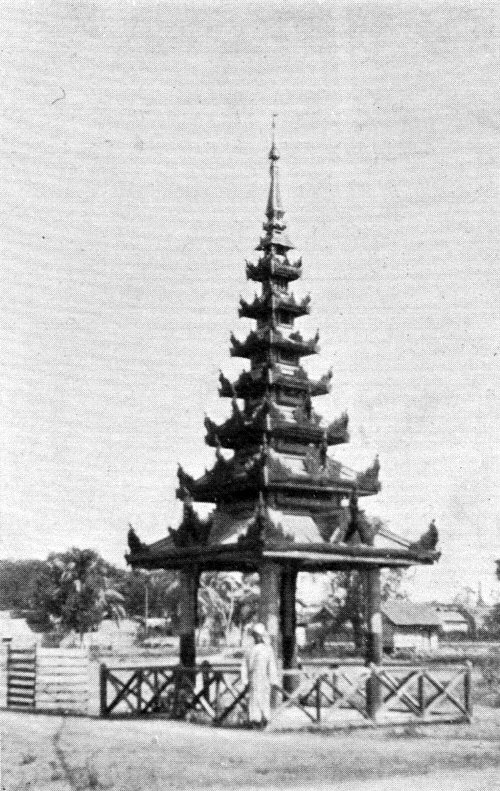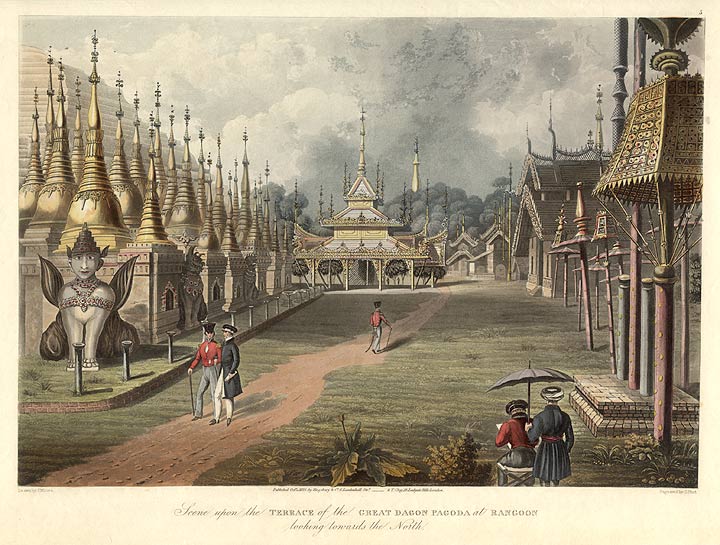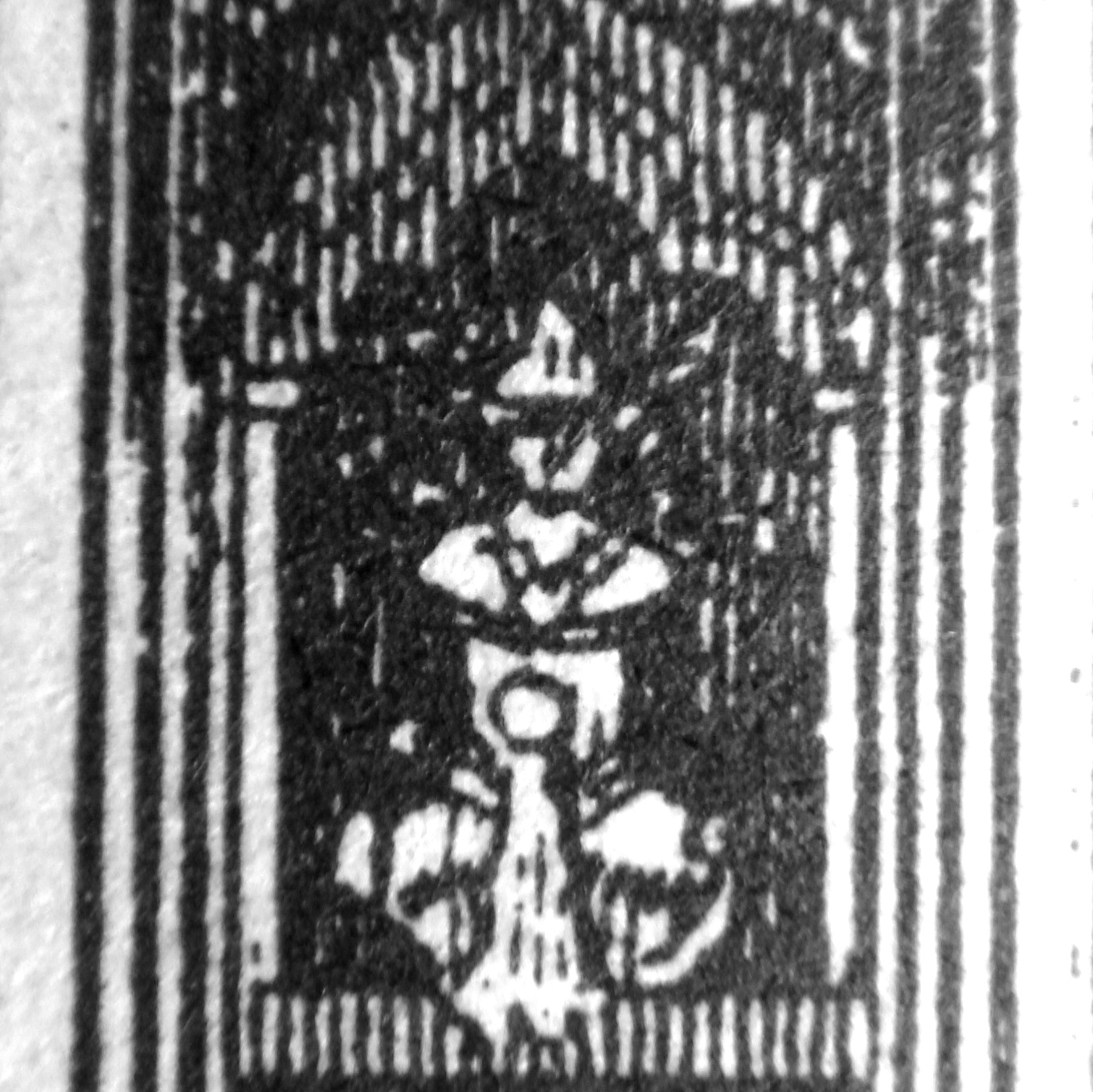|
Alaungpaya
Alaungpaya ( my, ßĆĪßĆ£ßĆ▒ßĆ¼ßĆäßĆ║ßĆĖßĆśßĆ»ßĆøßĆ¼ßĆĖ, ; also spelled Alaunghpaya or Alaung-Phra; 11 May 1760) was the founder of the Konbaung Dynasty of Burma (Myanmar). By the time of his death from illness during his campaign in Siam, this former chief of a small village in Upper Burma had unified Burma, subdued Manipur, conquered Lan Na and defeated the French and the British who had given help to the Restored Hanthawaddy Kingdom. He added settlements around Dagon, and called the enlarged town Yangon.Letwe Nawrahta and Maha Sithu of Twinthin 1961: 190ŌĆō191 He is considered one of the three greatest monarchs of Burma alongside Anawrahta and Bayinnaung for unifying Burma for the third time in Burmese history. Background The future king was born Aung Zeya ( "Victorious Victory") at Moksobo, a village of a few hundred households in the Mu River Valley about northwest of Ava (Inwa) on 24 August 1714 to Min Nyo San () and his wife Saw Nyein Oo (). He was the second son of a ... [...More Info...] [...Related Items...] OR: [Wikipedia] [Google] [Baidu] |
Hsinbyushin
Hsinbyushin ( my, ßĆåßĆäßĆ║ßĆ¢ßĆ╝ßĆ░ßĆøßĆŠßĆäßĆ║, , ; th, ÓĖ×ÓĖŻÓĖ░Ó╣ĆÓĖłÓ╣ēÓĖ▓ÓĖĪÓĖ▒ÓĖćÓĖŻÓĖ░; 12 September 1736 ŌĆō 10 June 1776) was king of the Konbaung dynasty of Burma (Myanmar) from 1763 to 1776. The second son of the dynasty founder Alaungpaya is best known for his wars with China and Siam, and is considered the most militaristic king of the dynasty. His successful defense against four Chinese invasions preserved Burmese independence. His invasion of Siam (1765ŌĆō1767) ended Siam's Ayutthaya Dynasty. The near simultaneous victories over China and Siam has been referred to as testimony "to a truly astonishing elan unmatched since Bayinnaung." He also raised the Shwedagon Pagoda to its current height in April 1775. The deputy commander-in-chief during his father's reunification campaigns (1752ŌĆō1759), Hsinbyushin as king pursued an expansionist policy against his neighbors. By 1767, his armies had put down a rebellion in Manipur, captured the Laotian states, temporar ... [...More Info...] [...Related Items...] OR: [Wikipedia] [Google] [Baidu] |
Shwebo
Shwebo ( my, ßĆøßĆĮßĆŠßĆ▒ßĆśßĆŁßĆ»ßĆÖßĆ╝ßĆŁßĆ»ßĆĘ ) is a city in Sagaing Region, Burma, 110 km north-west of Mandalay between the Irrawaddy and the Mu rivers. The city was the origin of the Konbaung Dynasty, established by King Alaungpaya in 1752, that was the dominant political force in Burma after the mid-18th century. It served as Alaungpaya's capital from 1752 to 1760. As of 2021, it has a population of 88,914. History Up to 1752, Shwebo was a village, called Moksobo ( my, ßĆÖßĆ»ßĆåßĆŁßĆ»ßĆĖßĆśßĆŁßĆ» ; ) of about 300 houses. It lies near the site of the ancient Pyu city-state of Hanlin. On 29 February 1752, the chief of the village Aung Zeya founded the Konbaung Dynasty to resist the upcoming invasion of Lower Burma-based Hanthawaddy forces. Aung Zeya, who also assumed the royal title of Alaungpaya, gained the allegiance of 46 surrounding villages, and organized defenses building a stockade and digging a moat around Moksobo. He renamed his village, Shwebo (). Over th ... [...More Info...] [...Related Items...] OR: [Wikipedia] [Google] [Baidu] |
Naungdawgyi
Dabayin Min ( my, ßĆÆßĆ«ßĆĢßĆ▓ßĆÜßĆäßĆ║ßĆĖßĆÖßĆäßĆ║ßĆĖ), commonly known as Naungdawgyi ( my, ßĆößĆ▒ßĆ¼ßĆäßĆ║ßĆÉßĆ▒ßĆ¼ßĆ║ßĆĆßĆ╝ßĆ«ßĆĖ ; 10 August 1734 ŌĆō 28 November 1763) was the second king of Konbaung Dynasty of Burma (Myanmar), from 1760 to 1763. He was a top military commander in his father Alaungpaya's reunification campaigns of the country. As king, he spent much of his short reign suppressing multiple rebellions across the newly founded kingdom from Ava (Inwa) and Toungoo (Taungoo) to Martaban (Mottama) and Chiang Mai. The king suddenly died less than a year after he had successfully suppressed the rebellions. He was succeeded by his younger brother Hsinbyushin. Early life Naungdawgyi was born Maung Lauk () to Yun San and Aung Zeya (later King Alaungpaya) on 10 August 1736 (Tuesday, 11th waxing of Wagaung 1096 ME) in a small village of Moksobo, about 60 miles northwest of Ava (Inwa).Maung Maung Tin Vol. 1 1905: 263 He was the eldest child of the couple's nine children ... [...More Info...] [...Related Items...] OR: [Wikipedia] [Google] [Baidu] |
Konbaung Dynasty
The Konbaung dynasty ( my, ßĆĆßĆ»ßĆößĆ║ßĆĖßĆśßĆ▒ßĆ¼ßĆäßĆ║ßĆüßĆ▒ßĆÉßĆ║, ), also known as Third Burmese Empire (ßĆÉßĆÉßĆŁßĆÜßĆÖßĆ╝ßĆößĆ║ßĆÖßĆ¼ßĆößĆŁßĆ»ßĆäßĆ║ßĆäßĆČßĆÉßĆ▒ßĆ¼ßĆ║) and formerly known as the Alompra dynasty (ßĆĪßĆ£ßĆ▒ßĆ¼ßĆäßĆ║ßĆĖßĆśßĆ»ßĆøßĆ¼ßĆĖßĆÖßĆäßĆ║ßĆĖßĆåßĆĆßĆ║, Alaungphra dynasty) and the Hunter dynasty (ßĆÖßĆ»ßĆåßĆŁßĆ»ßĆĖßĆÖßĆäßĆ║ßĆĖßĆåßĆĆßĆ║ Mokso dynasty / ßĆÖßĆ»ßĆåßĆŁßĆ»ßĆĖßĆśßĆŁßĆ»ßĆÖßĆäßĆ║ßĆĖßĆåßĆĆßĆ║ Moksobo dynasty), was the last dynasty that ruled Myanmar, Burma/Myanmar from 1752 to 1885. It created the second-largest empire in history of Myanmar, Burmese history and continued the administrative reforms begun by the Toungoo dynasty, laying the foundations of the modern state of Burma. The reforms, however, proved insufficient to stem the advance of the British Empire, British, who defeated the Burmese in all three Anglo-Burmese Wars over a six-decade span (1824ŌĆō1885) and ended the millennium-old Burmese monarchy in 1885. An expansionist dynasty, the K ... [...More Info...] [...Related Items...] OR: [Wikipedia] [Google] [Baidu] |
Konbaung Dynasty
The Konbaung dynasty ( my, ßĆĆßĆ»ßĆößĆ║ßĆĖßĆśßĆ▒ßĆ¼ßĆäßĆ║ßĆüßĆ▒ßĆÉßĆ║, ), also known as Third Burmese Empire (ßĆÉßĆÉßĆŁßĆÜßĆÖßĆ╝ßĆößĆ║ßĆÖßĆ¼ßĆößĆŁßĆ»ßĆäßĆ║ßĆäßĆČßĆÉßĆ▒ßĆ¼ßĆ║) and formerly known as the Alompra dynasty (ßĆĪßĆ£ßĆ▒ßĆ¼ßĆäßĆ║ßĆĖßĆśßĆ»ßĆøßĆ¼ßĆĖßĆÖßĆäßĆ║ßĆĖßĆåßĆĆßĆ║, Alaungphra dynasty) and the Hunter dynasty (ßĆÖßĆ»ßĆåßĆŁßĆ»ßĆĖßĆÖßĆäßĆ║ßĆĖßĆåßĆĆßĆ║ Mokso dynasty / ßĆÖßĆ»ßĆåßĆŁßĆ»ßĆĖßĆśßĆŁßĆ»ßĆÖßĆäßĆ║ßĆĖßĆåßĆĆßĆ║ Moksobo dynasty), was the last dynasty that ruled Myanmar, Burma/Myanmar from 1752 to 1885. It created the second-largest empire in history of Myanmar, Burmese history and continued the administrative reforms begun by the Toungoo dynasty, laying the foundations of the modern state of Burma. The reforms, however, proved insufficient to stem the advance of the British Empire, British, who defeated the Burmese in all three Anglo-Burmese Wars over a six-decade span (1824ŌĆō1885) and ended the millennium-old Burmese monarchy in 1885. An expansionist dynasty, the K ... [...More Info...] [...Related Items...] OR: [Wikipedia] [Google] [Baidu] |
Restored Hanthawaddy Kingdom
The Restored Hanthawaddy Kingdom ( my, ßƤßĆČßĆ×ßĆ¼ßĆØßĆÉßĆ« ßĆößĆ▒ßĆĢßĆ╝ßĆŖßĆ║ßĆÉßĆ▒ßĆ¼ßĆ║ßĆ×ßĆģßĆ║), also known as the Neo-Ramanic State () was the kingdom that ruled Lower Burma and parts of Upper Burma from 1740 to 1757. The kingdom grew out of a rebellion by the Mon led population of Pegu, who then rallied the other Mon as well as Delta Bama and Karens of Lower Burma, against the Toungoo Dynasty of Ava in Upper Burma. The rebellion succeeded in expelling Toungoo loyalists and restored the Mon-speaking Kingdom of Hanthawaddy ruled Lower Burma from 1287 to 1539. The restored Hanthawady kingdom also claim heritage to Bayinaung's early Toungoo Empire whose capital was based in Pegu and guaranteed the loyalty of the non-Mon population of Lower Burma. Supported by the French, the upstart kingdom quickly carved out a space for itself in Lower Burma, and continued its push northward. In March 1752, its forces captured Ava, and ended the 266-year-old Toungoo dynasty. A new dyna ... [...More Info...] [...Related Items...] OR: [Wikipedia] [Google] [Baidu] |
List Of Burmese Monarchs
This is a list of the monarchs of Burma (Myanmar), covering the monarchs of all the major kingdoms that existed in the present day Burma (Myanmar). Although Burmese chronicles, Burmese chronicle tradition maintains that various monarchies of Burma (Mon people, Mon, Bamar people, Burman, Rakhine people, Arakanese), began in the 9th century Common Era, BCE, historically verified data date back only to 1044 CE at the accession of Anawrahta of Pagan dynasty, Pagan. The farther away the data are from 1044, the less verifiable they are. For example, the founding of the city of Pagan (Bagan) in the 9th century is verifiableŌĆōalthough the accuracy of the actual date, given in the Chronicles as 849, remains in questionŌĆōbut the founding of early Pagan dynasty, given as the 2nd century, is not.Harvey 1925: 364 For early kingdoms, see List of early and legendary monarchs of Burma. The reign dates follow the latest available dates as discussed in each section. Early kingdoms * See List of ... [...More Info...] [...Related Items...] OR: [Wikipedia] [Google] [Baidu] |
Yun San
, image = , caption = , reign = 29 February 1752 ŌĆō 11 May 1760 , coronation = 17 April 1752 , succession = Chief Queen Consort of Burma , predecessor = Maha Nanda Dipadi Dewi , successor = Maha Mingala Yadana Dewi , suc-type = Successor , reg-type = , regent = , spouse = Alaungpaya , issue = Six sons, four daughters, including Naungdawgyi Hsinbyushin Bodawpaya , issue-link = , full name = Mah─ü Mangal─ü Ratan─üdhipati S─½rir─üj─ü Cand─üdev─½ , house = Siboktara , father = Thiri Yandaza U Phyo , mother = Daw Nyet , birth_date = 1713 , birth_place = Siboktara , death_date = , death_place = , date of burial = , place of burial = , religion = Theravada Buddhism , signature ... [...More Info...] [...Related Items...] OR: [Wikipedia] [Google] [Baidu] |
Bodawpaya
Bodawpaya ( my, ßĆśßĆŁßĆ»ßĆĖßĆÉßĆ▒ßĆ¼ßĆ║ßĆśßĆ»ßĆøßĆ¼ßĆĖ, ; th, ÓĖøÓĖöÓĖĖÓĖć; 11 March 1745 ŌĆō 5 June 1819) was the sixth king of the Konbaung dynasty of Burma. Born Maung Shwe Waing and later Badon Min, he was the fourth son of Alaungpaya, founder of the dynasty and the Third Burmese Empire. He was proclaimed king after deposing his nephew Phaungkaza Maung Maung, son of his eldest brother Naungdawgyi, at Ava. Bodawpaya moved the royal capital back to Amarapura in 1782. He was titled Hsinbyumyashin (Lord of the White Elephants), although he became known to posterity as Bodawpaya (Grandsire) in relation to his successor, his grandson Bagyidaw (Royal Elder Uncle), who in turn was given this name in relation to his nephew Mindon Min. He fathered 70 sons and 67 daughters by about 54 consorts. Military expeditions Also known as Bodaw U Waing, he invaded Arakan in 1784 sending his royal armies led by his son, the Heir Apparent Thado Minsaw, across the Western Yoma range of mountain ... [...More Info...] [...Related Items...] OR: [Wikipedia] [Google] [Baidu] |
Min Nyo San
Min Nyo San ( my, ßĆÖßĆäßĆ║ßĆĖßĆŖßĆŁßĆ»ßĆģßĆČ, ) was the father of King Alaungpaya, the founder of the Konbaung Dynasty of Burma (Myanmar). He was the mayor (headman) of Moksobo, and descended from the family that governed the Mu valley since the 15th century. He was awarded the royal title "Thiri Maha Dhamma Yaza" after his son became king.Letwe Nawrahta 1961: 13 References Bibliography * {{cite book , author=Letwe Nawrahta and Twinthin Taikwun , title=Alaungpaya Ayedawbon ''Alaungpaya Ayedawbon'' ( my, ßĆĪßĆ£ßĆ▒ßĆ¼ßĆäßĆ║ßĆĖßĆśßĆ»ßĆøßĆ¼ßĆĖ ßĆĪßĆøßĆ▒ßĆĖßĆÉßĆ▒ßĆ¼ßĆ║ßĆĢßĆ»ßĆČ), also known as ''Alaung Mintayagyi Ayedawbon'' ( my, ßĆĪßĆ£ßĆ▒ßĆ¼ßĆäßĆ║ßĆĖ ßĆÖßĆäßĆ║ßĆĖßĆÉßĆøßĆ¼ßĆĖßĆĆßĆ╝ßĆ«ßĆĖ ßĆĪßĆøßĆ▒ßĆĖßĆÉßĆ▒ßĆ¼ßĆ║ßĆĢßĆ»ß ... , editor=Hla Thamein , year=c. 1770 , publisher=Ministry of Culture, Union of Burma , edition=1961 , language=Burmese Konbaung dynasty ... [...More Info...] [...Related Items...] OR: [Wikipedia] [Google] [Baidu] |
Bayinnaung
, image = File:Bayinnaung.JPG , caption = Statue of Bayinnaung in front of the National Museum of Myanmar , reign = 30 April 1550 ŌĆō 10 October 1581 , coronation = 11 January 1551 at Toungoo 12 January 1554 at Pegu , succession = , predecessor = Tabinshwehti , successor = Nanda , suc-type = Successor , reg-type = Chief Minister , regent = Binnya Dala (1559ŌĆō1573) , succession1 = Suzerain of Lan Na , reign1 = 2 April 1558 ŌĆō 10 October 1581 , predecessor1 = ''New office'' , successor1 = Nanda , reg-type1 = King , regent1 = Mekuti (1558ŌĆō1563) Visuddhadevi (1565ŌĆō1579) Nawrahta Minsaw (1579ŌĆō1581) , succession2 = Suzerain of Siam , reign2 = 18 February 1564 ŌĆō 10 October 1581 , predecessor2 = ''New office'' , successor2 = Nand ... [...More Info...] [...Related Items...] OR: [Wikipedia] [Google] [Baidu] |
Saw Nyein Oo
Saw Nyein Oo ( my, ßĆģßĆ▒ßĆ¼ßĆäßĆ╝ßĆŁßĆÖßĆ║ßĆĖßĆ”ßĆĖ, ) was the mother of King Alaungpaya, the founder of the Konbaung Dynasty of Burma (Myanmar). She was awarded the royal title "Maha Dewi" after her second son became king.Letwe Nawrahta 1961: 13 References Bibliography * {{cite book , author=Letwe Nawrahta and Twinthin Taikwun , title=Alaungpaya Ayedawbon ''Alaungpaya Ayedawbon'' ( my, ßĆĪßĆ£ßĆ▒ßĆ¼ßĆäßĆ║ßĆĖßĆśßĆ»ßĆøßĆ¼ßĆĖ ßĆĪßĆøßĆ▒ßĆĖßĆÉßĆ▒ßĆ¼ßĆ║ßĆĢßĆ»ßĆČ), also known as ''Alaung Mintayagyi Ayedawbon'' ( my, ßĆĪßĆ£ßĆ▒ßĆ¼ßĆäßĆ║ßĆĖ ßĆÖßĆäßĆ║ßĆĖßĆÉßĆøßĆ¼ßĆĖßĆĆßĆ╝ßĆ«ßĆĖ ßĆĪßĆøßĆ▒ßĆĖßĆÉßĆ▒ßĆ¼ßĆ║ßĆĢßĆ»ß ... , editor=Hla Thamein , year=c. 1770 , publisher=Ministry of Culture, Union of Burma , edition=1961 , language=Burmese Konbaung dynasty ... [...More Info...] [...Related Items...] OR: [Wikipedia] [Google] [Baidu] |






.png)